Sustainable Biofuel Production: Turning Coffee Grounds into a Resource
VerifiedAdded on 2023/06/03
|6
|3259
|106
Report
AI Summary
This report, authored by Ahmed Elgamal, explores the potential of converting spent coffee grounds (SCGs) into biofuel as a sustainable alternative to traditional fossil fuels. The introduction highlights the need for liquid fuel decarbonization and the challenges associated with conventional biodiesel feedstocks, such as land and water resource pressures and greenhouse gas emissions. The paper focuses on the utilization of SCGs, a significant waste product, emphasizing its calorific value and potential for various applications, including biofuel production. The report details two primary processes for biofuel production from SCGs: oil extraction and transesterification, including the innovative situ transesterification method which combines oil extraction and transesterification in a single step. The report also discusses the work done by Lancaster University researchers in this area. Furthermore, the report highlights the success of Bio-bean, a company that has successfully utilized coffee waste to produce biofuel for London buses. The conclusion emphasizes the environmental benefits and the potential for large-scale biofuel production from coffee grounds, contributing to sustainable waste management and renewable energy solutions. References from various sources are provided to support the research and findings.
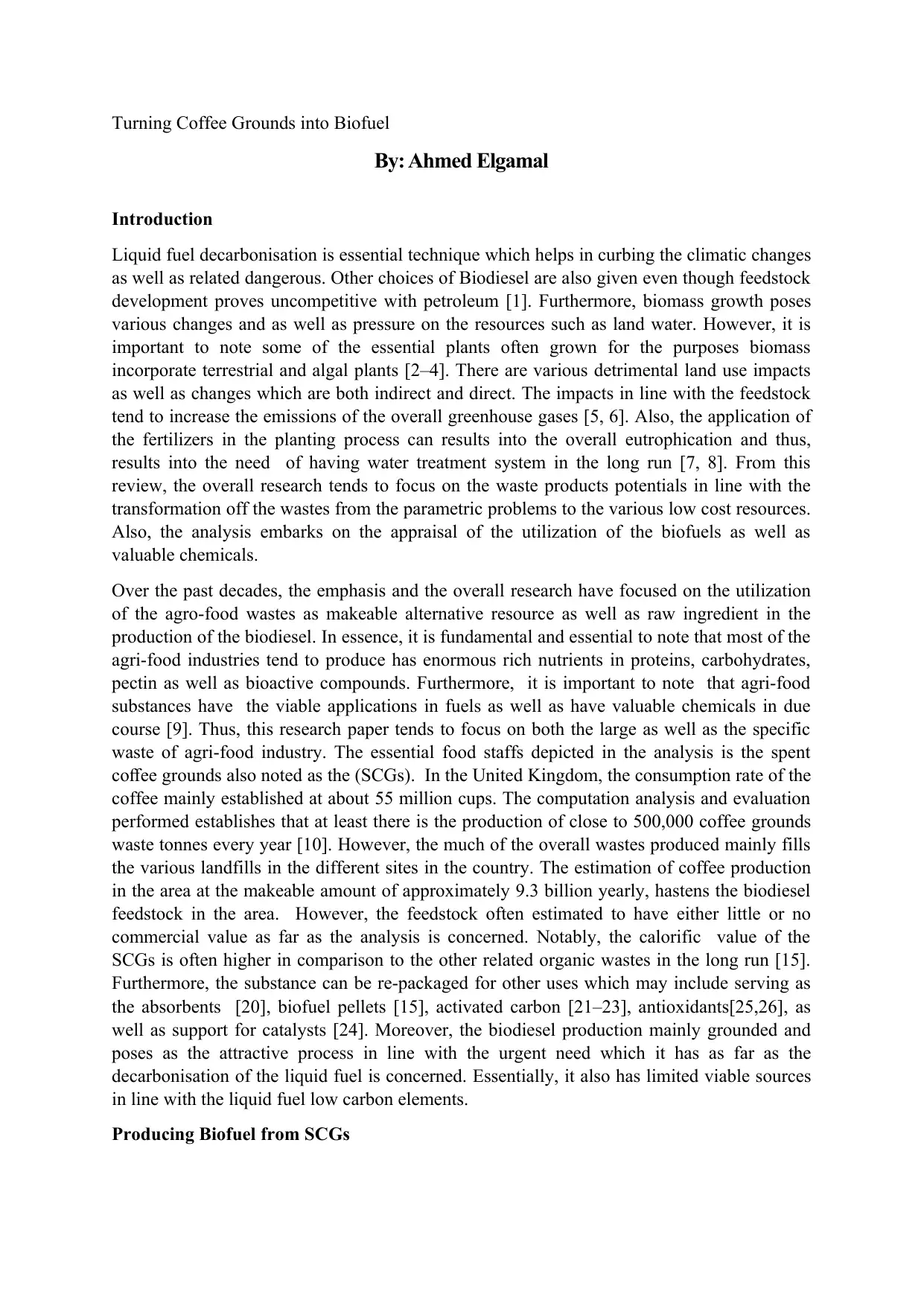
Turning Coffee Grounds into Biofuel
By: Ahmed Elgamal
Introduction
Liquid fuel decarbonisation is essential technique which helps in curbing the climatic changes
as well as related dangerous. Other choices of Biodiesel are also given even though feedstock
development proves uncompetitive with petroleum [1]. Furthermore, biomass growth poses
various changes and as well as pressure on the resources such as land water. However, it is
important to note some of the essential plants often grown for the purposes biomass
incorporate terrestrial and algal plants [2–4]. There are various detrimental land use impacts
as well as changes which are both indirect and direct. The impacts in line with the feedstock
tend to increase the emissions of the overall greenhouse gases [5, 6]. Also, the application of
the fertilizers in the planting process can results into the overall eutrophication and thus,
results into the need of having water treatment system in the long run [7, 8]. From this
review, the overall research tends to focus on the waste products potentials in line with the
transformation off the wastes from the parametric problems to the various low cost resources.
Also, the analysis embarks on the appraisal of the utilization of the biofuels as well as
valuable chemicals.
Over the past decades, the emphasis and the overall research have focused on the utilization
of the agro-food wastes as makeable alternative resource as well as raw ingredient in the
production of the biodiesel. In essence, it is fundamental and essential to note that most of the
agri-food industries tend to produce has enormous rich nutrients in proteins, carbohydrates,
pectin as well as bioactive compounds. Furthermore, it is important to note that agri-food
substances have the viable applications in fuels as well as have valuable chemicals in due
course [9]. Thus, this research paper tends to focus on both the large as well as the specific
waste of agri-food industry. The essential food staffs depicted in the analysis is the spent
coffee grounds also noted as the (SCGs). In the United Kingdom, the consumption rate of the
coffee mainly established at about 55 million cups. The computation analysis and evaluation
performed establishes that at least there is the production of close to 500,000 coffee grounds
waste tonnes every year [10]. However, the much of the overall wastes produced mainly fills
the various landfills in the different sites in the country. The estimation of coffee production
in the area at the makeable amount of approximately 9.3 billion yearly, hastens the biodiesel
feedstock in the area. However, the feedstock often estimated to have either little or no
commercial value as far as the analysis is concerned. Notably, the calorific value of the
SCGs is often higher in comparison to the other related organic wastes in the long run [15].
Furthermore, the substance can be re-packaged for other uses which may include serving as
the absorbents [20], biofuel pellets [15], activated carbon [21–23], antioxidants[25,26], as
well as support for catalysts [24]. Moreover, the biodiesel production mainly grounded and
poses as the attractive process in line with the urgent need which it has as far as the
decarbonisation of the liquid fuel is concerned. Essentially, it also has limited viable sources
in line with the liquid fuel low carbon elements.
Producing Biofuel from SCGs
By: Ahmed Elgamal
Introduction
Liquid fuel decarbonisation is essential technique which helps in curbing the climatic changes
as well as related dangerous. Other choices of Biodiesel are also given even though feedstock
development proves uncompetitive with petroleum [1]. Furthermore, biomass growth poses
various changes and as well as pressure on the resources such as land water. However, it is
important to note some of the essential plants often grown for the purposes biomass
incorporate terrestrial and algal plants [2–4]. There are various detrimental land use impacts
as well as changes which are both indirect and direct. The impacts in line with the feedstock
tend to increase the emissions of the overall greenhouse gases [5, 6]. Also, the application of
the fertilizers in the planting process can results into the overall eutrophication and thus,
results into the need of having water treatment system in the long run [7, 8]. From this
review, the overall research tends to focus on the waste products potentials in line with the
transformation off the wastes from the parametric problems to the various low cost resources.
Also, the analysis embarks on the appraisal of the utilization of the biofuels as well as
valuable chemicals.
Over the past decades, the emphasis and the overall research have focused on the utilization
of the agro-food wastes as makeable alternative resource as well as raw ingredient in the
production of the biodiesel. In essence, it is fundamental and essential to note that most of the
agri-food industries tend to produce has enormous rich nutrients in proteins, carbohydrates,
pectin as well as bioactive compounds. Furthermore, it is important to note that agri-food
substances have the viable applications in fuels as well as have valuable chemicals in due
course [9]. Thus, this research paper tends to focus on both the large as well as the specific
waste of agri-food industry. The essential food staffs depicted in the analysis is the spent
coffee grounds also noted as the (SCGs). In the United Kingdom, the consumption rate of the
coffee mainly established at about 55 million cups. The computation analysis and evaluation
performed establishes that at least there is the production of close to 500,000 coffee grounds
waste tonnes every year [10]. However, the much of the overall wastes produced mainly fills
the various landfills in the different sites in the country. The estimation of coffee production
in the area at the makeable amount of approximately 9.3 billion yearly, hastens the biodiesel
feedstock in the area. However, the feedstock often estimated to have either little or no
commercial value as far as the analysis is concerned. Notably, the calorific value of the
SCGs is often higher in comparison to the other related organic wastes in the long run [15].
Furthermore, the substance can be re-packaged for other uses which may include serving as
the absorbents [20], biofuel pellets [15], activated carbon [21–23], antioxidants[25,26], as
well as support for catalysts [24]. Moreover, the biodiesel production mainly grounded and
poses as the attractive process in line with the urgent need which it has as far as the
decarbonisation of the liquid fuel is concerned. Essentially, it also has limited viable sources
in line with the liquid fuel low carbon elements.
Producing Biofuel from SCGs
Paraphrase This Document
Need a fresh take? Get an instant paraphrase of this document with our AI Paraphraser
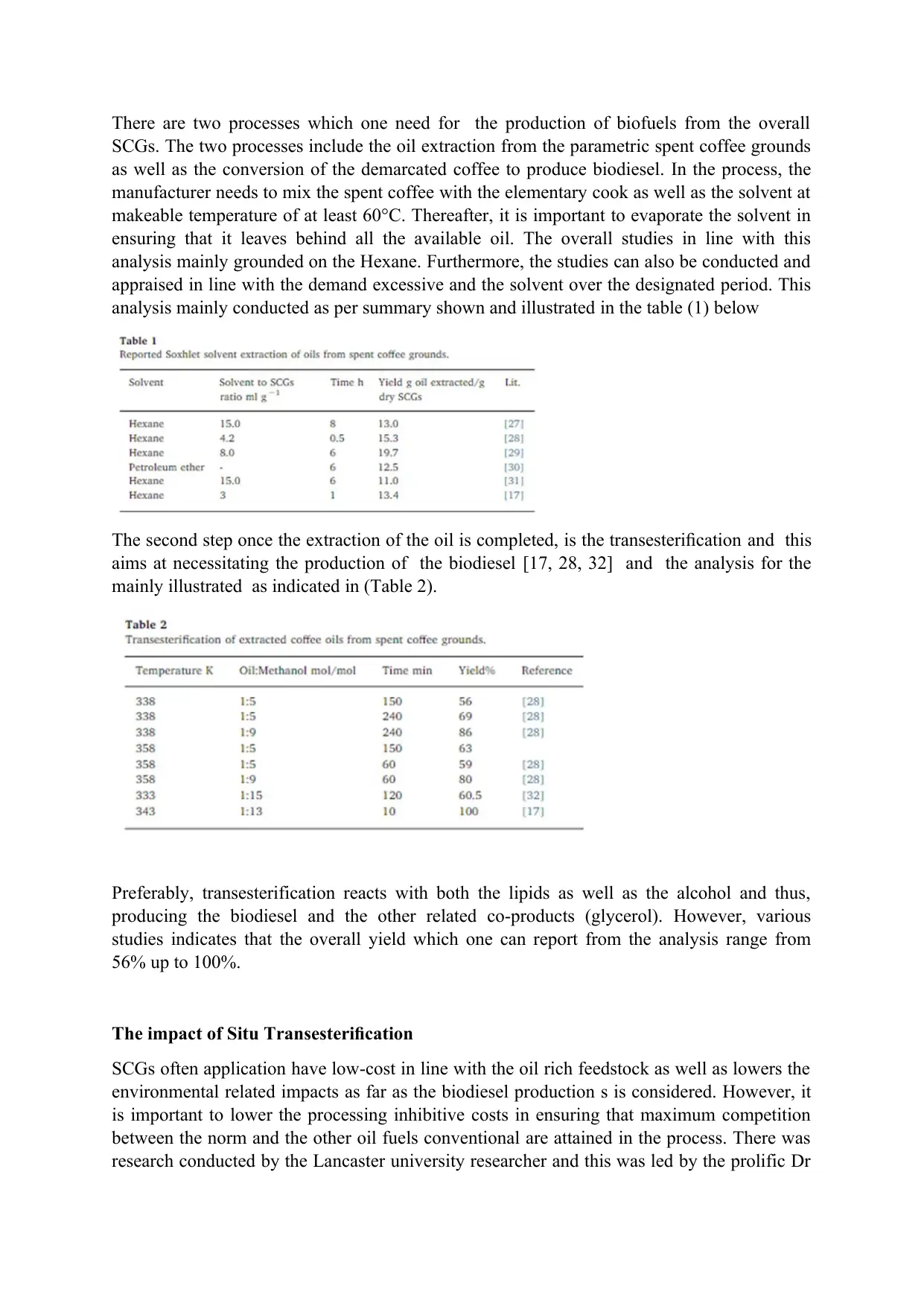
There are two processes which one need for the production of biofuels from the overall
SCGs. The two processes include the oil extraction from the parametric spent coffee grounds
as well as the conversion of the demarcated coffee to produce biodiesel. In the process, the
manufacturer needs to mix the spent coffee with the elementary cook as well as the solvent at
makeable temperature of at least 60°C. Thereafter, it is important to evaporate the solvent in
ensuring that it leaves behind all the available oil. The overall studies in line with this
analysis mainly grounded on the Hexane. Furthermore, the studies can also be conducted and
appraised in line with the demand excessive and the solvent over the designated period. This
analysis mainly conducted as per summary shown and illustrated in the table (1) below
The second step once the extraction of the oil is completed, is the transesterification and this
aims at necessitating the production of the biodiesel [17, 28, 32] and the analysis for the
mainly illustrated as indicated in (Table 2).
Preferably, transesterification reacts with both the lipids as well as the alcohol and thus,
producing the biodiesel and the other related co-products (glycerol). However, various
studies indicates that the overall yield which one can report from the analysis range from
56% up to 100%.
The impact of Situ Transesterification
SCGs often application have low-cost in line with the oil rich feedstock as well as lowers the
environmental related impacts as far as the biodiesel production s is considered. However, it
is important to lower the processing inhibitive costs in ensuring that maximum competition
between the norm and the other oil fuels conventional are attained in the process. There was
research conducted by the Lancaster university researcher and this was led by the prolific Dr
SCGs. The two processes include the oil extraction from the parametric spent coffee grounds
as well as the conversion of the demarcated coffee to produce biodiesel. In the process, the
manufacturer needs to mix the spent coffee with the elementary cook as well as the solvent at
makeable temperature of at least 60°C. Thereafter, it is important to evaporate the solvent in
ensuring that it leaves behind all the available oil. The overall studies in line with this
analysis mainly grounded on the Hexane. Furthermore, the studies can also be conducted and
appraised in line with the demand excessive and the solvent over the designated period. This
analysis mainly conducted as per summary shown and illustrated in the table (1) below
The second step once the extraction of the oil is completed, is the transesterification and this
aims at necessitating the production of the biodiesel [17, 28, 32] and the analysis for the
mainly illustrated as indicated in (Table 2).
Preferably, transesterification reacts with both the lipids as well as the alcohol and thus,
producing the biodiesel and the other related co-products (glycerol). However, various
studies indicates that the overall yield which one can report from the analysis range from
56% up to 100%.
The impact of Situ Transesterification
SCGs often application have low-cost in line with the oil rich feedstock as well as lowers the
environmental related impacts as far as the biodiesel production s is considered. However, it
is important to lower the processing inhibitive costs in ensuring that maximum competition
between the norm and the other oil fuels conventional are attained in the process. There was
research conducted by the Lancaster university researcher and this was led by the prolific Dr
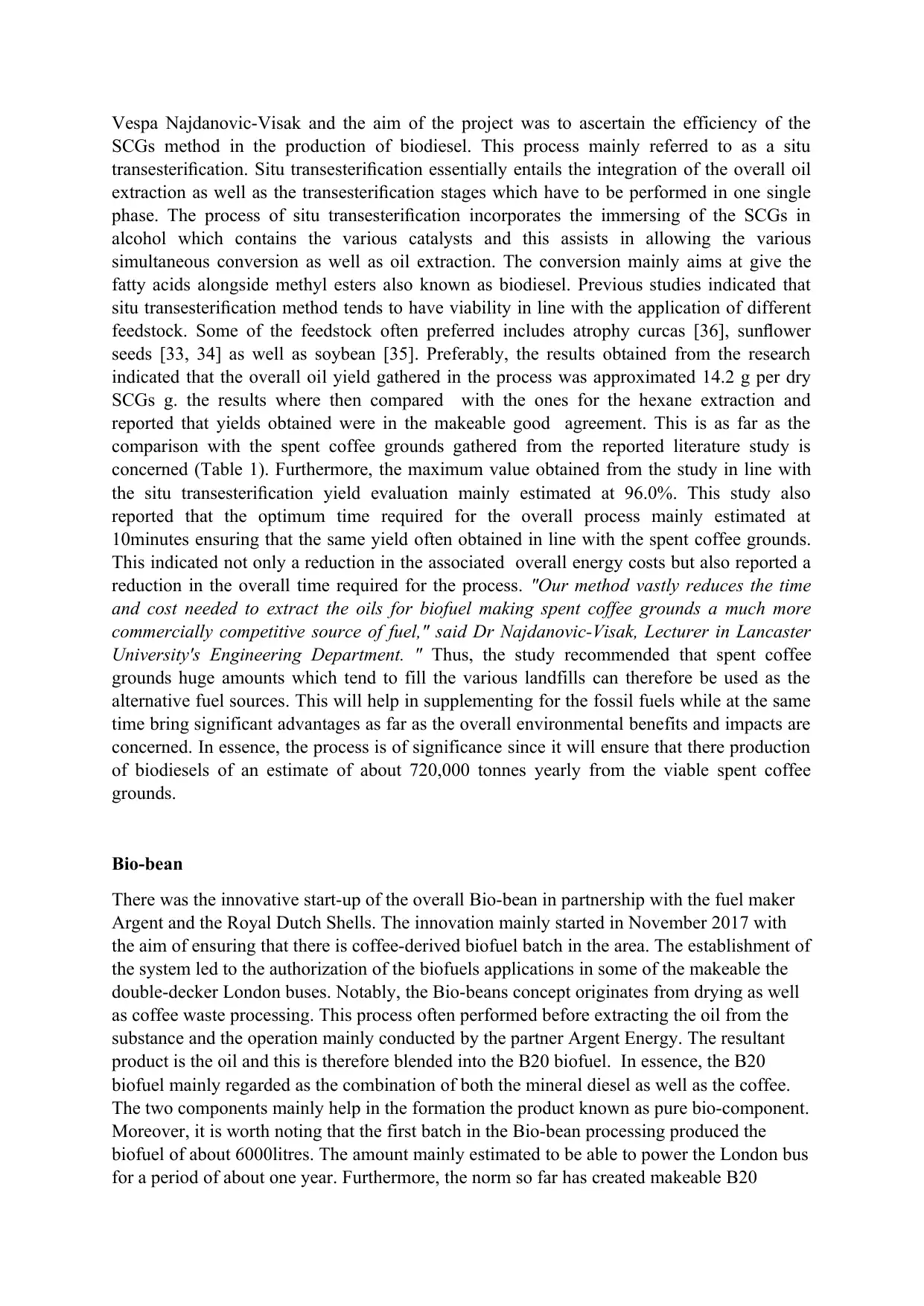
Vespa Najdanovic-Visak and the aim of the project was to ascertain the efficiency of the
SCGs method in the production of biodiesel. This process mainly referred to as a situ
transesterification. Situ transesterification essentially entails the integration of the overall oil
extraction as well as the transesterification stages which have to be performed in one single
phase. The process of situ transesterification incorporates the immersing of the SCGs in
alcohol which contains the various catalysts and this assists in allowing the various
simultaneous conversion as well as oil extraction. The conversion mainly aims at give the
fatty acids alongside methyl esters also known as biodiesel. Previous studies indicated that
situ transesterification method tends to have viability in line with the application of different
feedstock. Some of the feedstock often preferred includes atrophy curcas [36], sunflower
seeds [33, 34] as well as soybean [35]. Preferably, the results obtained from the research
indicated that the overall oil yield gathered in the process was approximated 14.2 g per dry
SCGs g. the results where then compared with the ones for the hexane extraction and
reported that yields obtained were in the makeable good agreement. This is as far as the
comparison with the spent coffee grounds gathered from the reported literature study is
concerned (Table 1). Furthermore, the maximum value obtained from the study in line with
the situ transesterification yield evaluation mainly estimated at 96.0%. This study also
reported that the optimum time required for the overall process mainly estimated at
10minutes ensuring that the same yield often obtained in line with the spent coffee grounds.
This indicated not only a reduction in the associated overall energy costs but also reported a
reduction in the overall time required for the process. "Our method vastly reduces the time
and cost needed to extract the oils for biofuel making spent coffee grounds a much more
commercially competitive source of fuel," said Dr Najdanovic-Visak, Lecturer in Lancaster
University's Engineering Department. " Thus, the study recommended that spent coffee
grounds huge amounts which tend to fill the various landfills can therefore be used as the
alternative fuel sources. This will help in supplementing for the fossil fuels while at the same
time bring significant advantages as far as the overall environmental benefits and impacts are
concerned. In essence, the process is of significance since it will ensure that there production
of biodiesels of an estimate of about 720,000 tonnes yearly from the viable spent coffee
grounds.
Bio-bean
There was the innovative start-up of the overall Bio-bean in partnership with the fuel maker
Argent and the Royal Dutch Shells. The innovation mainly started in November 2017 with
the aim of ensuring that there is coffee-derived biofuel batch in the area. The establishment of
the system led to the authorization of the biofuels applications in some of the makeable the
double-decker London buses. Notably, the Bio-beans concept originates from drying as well
as coffee waste processing. This process often performed before extracting the oil from the
substance and the operation mainly conducted by the partner Argent Energy. The resultant
product is the oil and this is therefore blended into the B20 biofuel. In essence, the B20
biofuel mainly regarded as the combination of both the mineral diesel as well as the coffee.
The two components mainly help in the formation the product known as pure bio-component.
Moreover, it is worth noting that the first batch in the Bio-bean processing produced the
biofuel of about 6000litres. The amount mainly estimated to be able to power the London bus
for a period of about one year. Furthermore, the norm so far has created makeable B20
SCGs method in the production of biodiesel. This process mainly referred to as a situ
transesterification. Situ transesterification essentially entails the integration of the overall oil
extraction as well as the transesterification stages which have to be performed in one single
phase. The process of situ transesterification incorporates the immersing of the SCGs in
alcohol which contains the various catalysts and this assists in allowing the various
simultaneous conversion as well as oil extraction. The conversion mainly aims at give the
fatty acids alongside methyl esters also known as biodiesel. Previous studies indicated that
situ transesterification method tends to have viability in line with the application of different
feedstock. Some of the feedstock often preferred includes atrophy curcas [36], sunflower
seeds [33, 34] as well as soybean [35]. Preferably, the results obtained from the research
indicated that the overall oil yield gathered in the process was approximated 14.2 g per dry
SCGs g. the results where then compared with the ones for the hexane extraction and
reported that yields obtained were in the makeable good agreement. This is as far as the
comparison with the spent coffee grounds gathered from the reported literature study is
concerned (Table 1). Furthermore, the maximum value obtained from the study in line with
the situ transesterification yield evaluation mainly estimated at 96.0%. This study also
reported that the optimum time required for the overall process mainly estimated at
10minutes ensuring that the same yield often obtained in line with the spent coffee grounds.
This indicated not only a reduction in the associated overall energy costs but also reported a
reduction in the overall time required for the process. "Our method vastly reduces the time
and cost needed to extract the oils for biofuel making spent coffee grounds a much more
commercially competitive source of fuel," said Dr Najdanovic-Visak, Lecturer in Lancaster
University's Engineering Department. " Thus, the study recommended that spent coffee
grounds huge amounts which tend to fill the various landfills can therefore be used as the
alternative fuel sources. This will help in supplementing for the fossil fuels while at the same
time bring significant advantages as far as the overall environmental benefits and impacts are
concerned. In essence, the process is of significance since it will ensure that there production
of biodiesels of an estimate of about 720,000 tonnes yearly from the viable spent coffee
grounds.
Bio-bean
There was the innovative start-up of the overall Bio-bean in partnership with the fuel maker
Argent and the Royal Dutch Shells. The innovation mainly started in November 2017 with
the aim of ensuring that there is coffee-derived biofuel batch in the area. The establishment of
the system led to the authorization of the biofuels applications in some of the makeable the
double-decker London buses. Notably, the Bio-beans concept originates from drying as well
as coffee waste processing. This process often performed before extracting the oil from the
substance and the operation mainly conducted by the partner Argent Energy. The resultant
product is the oil and this is therefore blended into the B20 biofuel. In essence, the B20
biofuel mainly regarded as the combination of both the mineral diesel as well as the coffee.
The two components mainly help in the formation the product known as pure bio-component.
Moreover, it is worth noting that the first batch in the Bio-bean processing produced the
biofuel of about 6000litres. The amount mainly estimated to be able to power the London bus
for a period of about one year. Furthermore, the norm so far has created makeable B20
⊘ This is a preview!⊘
Do you want full access?
Subscribe today to unlock all pages.

Trusted by 1+ million students worldwide
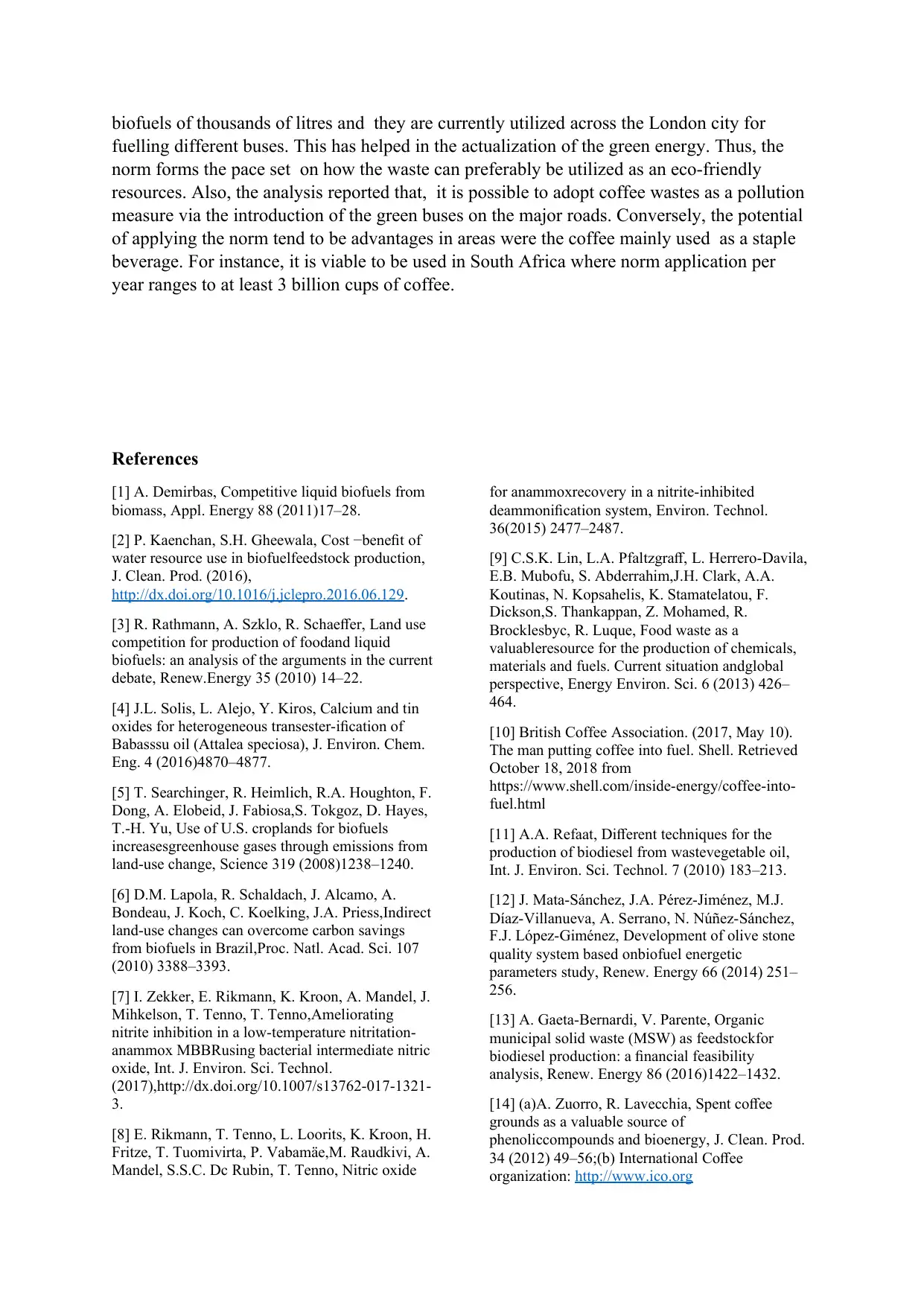
biofuels of thousands of litres and they are currently utilized across the London city for
fuelling different buses. This has helped in the actualization of the green energy. Thus, the
norm forms the pace set on how the waste can preferably be utilized as an eco-friendly
resources. Also, the analysis reported that, it is possible to adopt coffee wastes as a pollution
measure via the introduction of the green buses on the major roads. Conversely, the potential
of applying the norm tend to be advantages in areas were the coffee mainly used as a staple
beverage. For instance, it is viable to be used in South Africa where norm application per
year ranges to at least 3 billion cups of coffee.
References
[1] A. Demirbas, Competitive liquid biofuels from
biomass, Appl. Energy 88 (2011)17–28.
[2] P. Kaenchan, S.H. Gheewala, Cost −benefit of
water resource use in biofuelfeedstock production,
J. Clean. Prod. (2016),
http://dx.doi.org/10.1016/j.jclepro.2016.06.129.
[3] R. Rathmann, A. Szklo, R. Schaeffer, Land use
competition for production of foodand liquid
biofuels: an analysis of the arguments in the current
debate, Renew.Energy 35 (2010) 14–22.
[4] J.L. Solis, L. Alejo, Y. Kiros, Calcium and tin
oxides for heterogeneous transester-ification of
Babasssu oil (Attalea speciosa), J. Environ. Chem.
Eng. 4 (2016)4870–4877.
[5] T. Searchinger, R. Heimlich, R.A. Houghton, F.
Dong, A. Elobeid, J. Fabiosa,S. Tokgoz, D. Hayes,
T.-H. Yu, Use of U.S. croplands for biofuels
increasesgreenhouse gases through emissions from
land-use change, Science 319 (2008)1238–1240.
[6] D.M. Lapola, R. Schaldach, J. Alcamo, A.
Bondeau, J. Koch, C. Koelking, J.A. Priess,Indirect
land-use changes can overcome carbon savings
from biofuels in Brazil,Proc. Natl. Acad. Sci. 107
(2010) 3388–3393.
[7] I. Zekker, E. Rikmann, K. Kroon, A. Mandel, J.
Mihkelson, T. Tenno, T. Tenno,Ameliorating
nitrite inhibition in a low-temperature nitritation-
anammox MBBRusing bacterial intermediate nitric
oxide, Int. J. Environ. Sci. Technol.
(2017),http://dx.doi.org/10.1007/s13762-017-1321-
3.
[8] E. Rikmann, T. Tenno, L. Loorits, K. Kroon, H.
Fritze, T. Tuomivirta, P. Vabamäe,M. Raudkivi, A.
Mandel, S.S.C. Dc Rubin, T. Tenno, Nitric oxide
for anammoxrecovery in a nitrite-inhibited
deammonification system, Environ. Technol.
36(2015) 2477–2487.
[9] C.S.K. Lin, L.A. Pfaltzgraff, L. Herrero-Davila,
E.B. Mubofu, S. Abderrahim,J.H. Clark, A.A.
Koutinas, N. Kopsahelis, K. Stamatelatou, F.
Dickson,S. Thankappan, Z. Mohamed, R.
Brocklesbyc, R. Luque, Food waste as a
valuableresource for the production of chemicals,
materials and fuels. Current situation andglobal
perspective, Energy Environ. Sci. 6 (2013) 426–
464.
[10] British Coffee Association. (2017, May 10).
The man putting coffee into fuel. Shell. Retrieved
October 18, 2018 from
https://www.shell.com/inside-energy/coffee-into-
fuel.html
[11] A.A. Refaat, Different techniques for the
production of biodiesel from wastevegetable oil,
Int. J. Environ. Sci. Technol. 7 (2010) 183–213.
[12] J. Mata-Sánchez, J.A. Pérez-Jiménez, M.J.
Díaz-Villanueva, A. Serrano, N. Núñez-Sánchez,
F.J. López-Giménez, Development of olive stone
quality system based onbiofuel energetic
parameters study, Renew. Energy 66 (2014) 251–
256.
[13] A. Gaeta-Bernardi, V. Parente, Organic
municipal solid waste (MSW) as feedstockfor
biodiesel production: a financial feasibility
analysis, Renew. Energy 86 (2016)1422–1432.
[14] (a)A. Zuorro, R. Lavecchia, Spent coffee
grounds as a valuable source of
phenoliccompounds and bioenergy, J. Clean. Prod.
34 (2012) 49–56;(b) International Coffee
organization: http://www.ico.org
fuelling different buses. This has helped in the actualization of the green energy. Thus, the
norm forms the pace set on how the waste can preferably be utilized as an eco-friendly
resources. Also, the analysis reported that, it is possible to adopt coffee wastes as a pollution
measure via the introduction of the green buses on the major roads. Conversely, the potential
of applying the norm tend to be advantages in areas were the coffee mainly used as a staple
beverage. For instance, it is viable to be used in South Africa where norm application per
year ranges to at least 3 billion cups of coffee.
References
[1] A. Demirbas, Competitive liquid biofuels from
biomass, Appl. Energy 88 (2011)17–28.
[2] P. Kaenchan, S.H. Gheewala, Cost −benefit of
water resource use in biofuelfeedstock production,
J. Clean. Prod. (2016),
http://dx.doi.org/10.1016/j.jclepro.2016.06.129.
[3] R. Rathmann, A. Szklo, R. Schaeffer, Land use
competition for production of foodand liquid
biofuels: an analysis of the arguments in the current
debate, Renew.Energy 35 (2010) 14–22.
[4] J.L. Solis, L. Alejo, Y. Kiros, Calcium and tin
oxides for heterogeneous transester-ification of
Babasssu oil (Attalea speciosa), J. Environ. Chem.
Eng. 4 (2016)4870–4877.
[5] T. Searchinger, R. Heimlich, R.A. Houghton, F.
Dong, A. Elobeid, J. Fabiosa,S. Tokgoz, D. Hayes,
T.-H. Yu, Use of U.S. croplands for biofuels
increasesgreenhouse gases through emissions from
land-use change, Science 319 (2008)1238–1240.
[6] D.M. Lapola, R. Schaldach, J. Alcamo, A.
Bondeau, J. Koch, C. Koelking, J.A. Priess,Indirect
land-use changes can overcome carbon savings
from biofuels in Brazil,Proc. Natl. Acad. Sci. 107
(2010) 3388–3393.
[7] I. Zekker, E. Rikmann, K. Kroon, A. Mandel, J.
Mihkelson, T. Tenno, T. Tenno,Ameliorating
nitrite inhibition in a low-temperature nitritation-
anammox MBBRusing bacterial intermediate nitric
oxide, Int. J. Environ. Sci. Technol.
(2017),http://dx.doi.org/10.1007/s13762-017-1321-
3.
[8] E. Rikmann, T. Tenno, L. Loorits, K. Kroon, H.
Fritze, T. Tuomivirta, P. Vabamäe,M. Raudkivi, A.
Mandel, S.S.C. Dc Rubin, T. Tenno, Nitric oxide
for anammoxrecovery in a nitrite-inhibited
deammonification system, Environ. Technol.
36(2015) 2477–2487.
[9] C.S.K. Lin, L.A. Pfaltzgraff, L. Herrero-Davila,
E.B. Mubofu, S. Abderrahim,J.H. Clark, A.A.
Koutinas, N. Kopsahelis, K. Stamatelatou, F.
Dickson,S. Thankappan, Z. Mohamed, R.
Brocklesbyc, R. Luque, Food waste as a
valuableresource for the production of chemicals,
materials and fuels. Current situation andglobal
perspective, Energy Environ. Sci. 6 (2013) 426–
464.
[10] British Coffee Association. (2017, May 10).
The man putting coffee into fuel. Shell. Retrieved
October 18, 2018 from
https://www.shell.com/inside-energy/coffee-into-
fuel.html
[11] A.A. Refaat, Different techniques for the
production of biodiesel from wastevegetable oil,
Int. J. Environ. Sci. Technol. 7 (2010) 183–213.
[12] J. Mata-Sánchez, J.A. Pérez-Jiménez, M.J.
Díaz-Villanueva, A. Serrano, N. Núñez-Sánchez,
F.J. López-Giménez, Development of olive stone
quality system based onbiofuel energetic
parameters study, Renew. Energy 66 (2014) 251–
256.
[13] A. Gaeta-Bernardi, V. Parente, Organic
municipal solid waste (MSW) as feedstockfor
biodiesel production: a financial feasibility
analysis, Renew. Energy 86 (2016)1422–1432.
[14] (a)A. Zuorro, R. Lavecchia, Spent coffee
grounds as a valuable source of
phenoliccompounds and bioenergy, J. Clean. Prod.
34 (2012) 49–56;(b) International Coffee
organization: http://www.ico.org
Paraphrase This Document
Need a fresh take? Get an instant paraphrase of this document with our AI Paraphraser
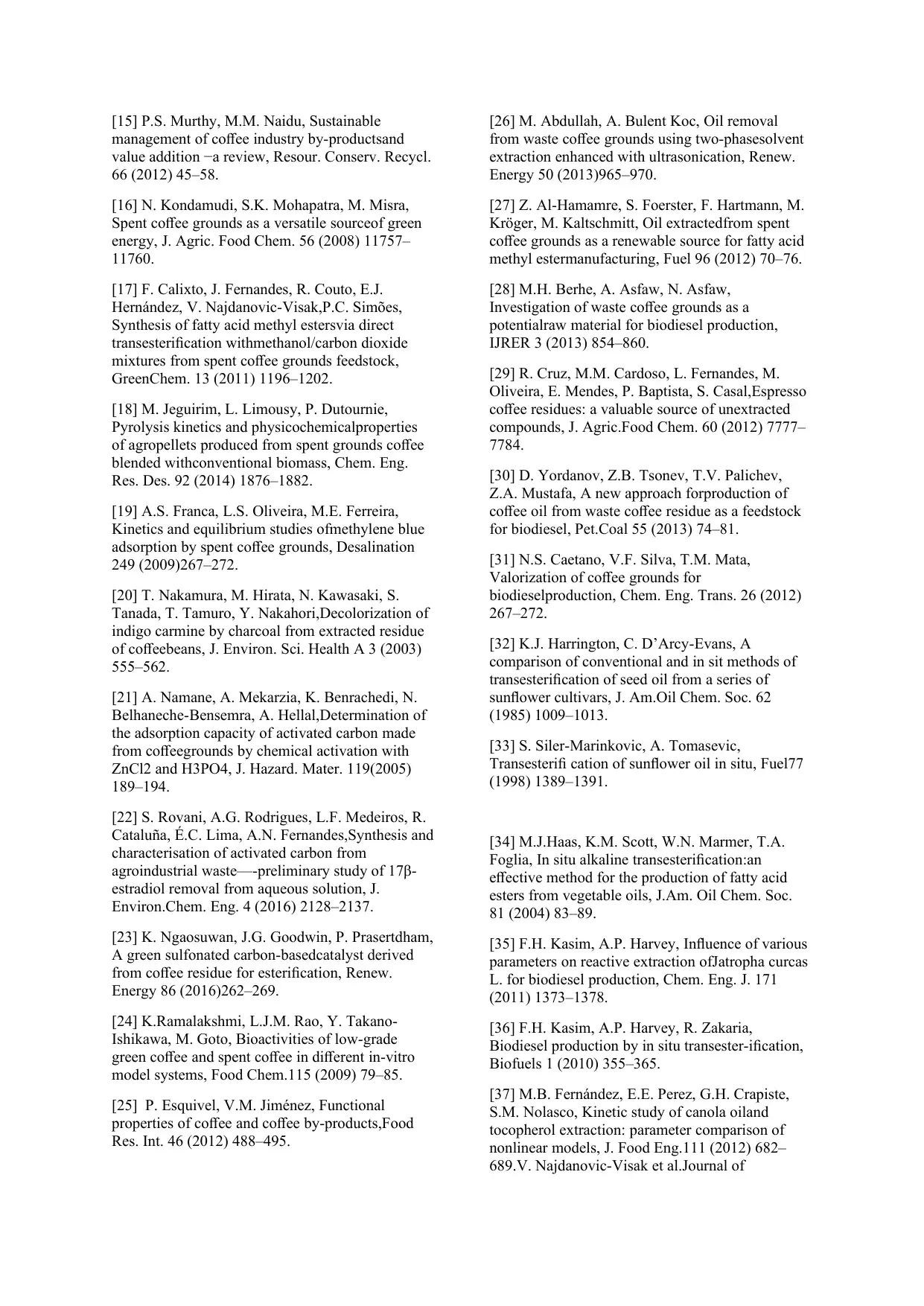
[15] P.S. Murthy, M.M. Naidu, Sustainable
management of coffee industry by-productsand
value addition −a review, Resour. Conserv. Recycl.
66 (2012) 45–58.
[16] N. Kondamudi, S.K. Mohapatra, M. Misra,
Spent coffee grounds as a versatile sourceof green
energy, J. Agric. Food Chem. 56 (2008) 11757–
11760.
[17] F. Calixto, J. Fernandes, R. Couto, E.J.
Hernández, V. Najdanovic-Visak,P.C. Simões,
Synthesis of fatty acid methyl estersvia direct
transesterification withmethanol/carbon dioxide
mixtures from spent coffee grounds feedstock,
GreenChem. 13 (2011) 1196–1202.
[18] M. Jeguirim, L. Limousy, P. Dutournie,
Pyrolysis kinetics and physicochemicalproperties
of agropellets produced from spent grounds coffee
blended withconventional biomass, Chem. Eng.
Res. Des. 92 (2014) 1876–1882.
[19] A.S. Franca, L.S. Oliveira, M.E. Ferreira,
Kinetics and equilibrium studies ofmethylene blue
adsorption by spent coffee grounds, Desalination
249 (2009)267–272.
[20] T. Nakamura, M. Hirata, N. Kawasaki, S.
Tanada, T. Tamuro, Y. Nakahori,Decolorization of
indigo carmine by charcoal from extracted residue
of coffeebeans, J. Environ. Sci. Health A 3 (2003)
555–562.
[21] A. Namane, A. Mekarzia, K. Benrachedi, N.
Belhaneche-Bensemra, A. Hellal,Determination of
the adsorption capacity of activated carbon made
from coffeegrounds by chemical activation with
ZnCl2 and H3PO4, J. Hazard. Mater. 119(2005)
189–194.
[22] S. Rovani, A.G. Rodrigues, L.F. Medeiros, R.
Cataluña, É.C. Lima, A.N. Fernandes,Synthesis and
characterisation of activated carbon from
agroindustrial waste—-preliminary study of 17β-
estradiol removal from aqueous solution, J.
Environ.Chem. Eng. 4 (2016) 2128–2137.
[23] K. Ngaosuwan, J.G. Goodwin, P. Prasertdham,
A green sulfonated carbon-basedcatalyst derived
from coffee residue for esterification, Renew.
Energy 86 (2016)262–269.
[24] K.Ramalakshmi, L.J.M. Rao, Y. Takano-
Ishikawa, M. Goto, Bioactivities of low-grade
green coffee and spent coffee in different in-vitro
model systems, Food Chem.115 (2009) 79–85.
[25] P. Esquivel, V.M. Jiménez, Functional
properties of coffee and coffee by-products,Food
Res. Int. 46 (2012) 488–495.
[26] M. Abdullah, A. Bulent Koc, Oil removal
from waste coffee grounds using two-phasesolvent
extraction enhanced with ultrasonication, Renew.
Energy 50 (2013)965–970.
[27] Z. Al-Hamamre, S. Foerster, F. Hartmann, M.
Kröger, M. Kaltschmitt, Oil extractedfrom spent
coffee grounds as a renewable source for fatty acid
methyl estermanufacturing, Fuel 96 (2012) 70–76.
[28] M.H. Berhe, A. Asfaw, N. Asfaw,
Investigation of waste coffee grounds as a
potentialraw material for biodiesel production,
IJRER 3 (2013) 854–860.
[29] R. Cruz, M.M. Cardoso, L. Fernandes, M.
Oliveira, E. Mendes, P. Baptista, S. Casal,Espresso
coffee residues: a valuable source of unextracted
compounds, J. Agric.Food Chem. 60 (2012) 7777–
7784.
[30] D. Yordanov, Z.B. Tsonev, T.V. Palichev,
Z.A. Mustafa, A new approach forproduction of
coffee oil from waste coffee residue as a feedstock
for biodiesel, Pet.Coal 55 (2013) 74–81.
[31] N.S. Caetano, V.F. Silva, T.M. Mata,
Valorization of coffee grounds for
biodieselproduction, Chem. Eng. Trans. 26 (2012)
267–272.
[32] K.J. Harrington, C. D’Arcy-Evans, A
comparison of conventional and in sit methods of
transesterification of seed oil from a series of
sunflower cultivars, J. Am.Oil Chem. Soc. 62
(1985) 1009–1013.
[33] S. Siler-Marinkovic, A. Tomasevic,
Transesterifi cation of sunflower oil in situ, Fuel77
(1998) 1389–1391.
[34] M.J.Haas, K.M. Scott, W.N. Marmer, T.A.
Foglia, In situ alkaline transesterification:an
effective method for the production of fatty acid
esters from vegetable oils, J.Am. Oil Chem. Soc.
81 (2004) 83–89.
[35] F.H. Kasim, A.P. Harvey, Influence of various
parameters on reactive extraction ofJatropha curcas
L. for biodiesel production, Chem. Eng. J. 171
(2011) 1373–1378.
[36] F.H. Kasim, A.P. Harvey, R. Zakaria,
Biodiesel production by in situ transester-ification,
Biofuels 1 (2010) 355–365.
[37] M.B. Fernández, E.E. Perez, G.H. Crapiste,
S.M. Nolasco, Kinetic study of canola oiland
tocopherol extraction: parameter comparison of
nonlinear models, J. Food Eng.111 (2012) 682–
689.V. Najdanovic-Visak et al.Journal of
management of coffee industry by-productsand
value addition −a review, Resour. Conserv. Recycl.
66 (2012) 45–58.
[16] N. Kondamudi, S.K. Mohapatra, M. Misra,
Spent coffee grounds as a versatile sourceof green
energy, J. Agric. Food Chem. 56 (2008) 11757–
11760.
[17] F. Calixto, J. Fernandes, R. Couto, E.J.
Hernández, V. Najdanovic-Visak,P.C. Simões,
Synthesis of fatty acid methyl estersvia direct
transesterification withmethanol/carbon dioxide
mixtures from spent coffee grounds feedstock,
GreenChem. 13 (2011) 1196–1202.
[18] M. Jeguirim, L. Limousy, P. Dutournie,
Pyrolysis kinetics and physicochemicalproperties
of agropellets produced from spent grounds coffee
blended withconventional biomass, Chem. Eng.
Res. Des. 92 (2014) 1876–1882.
[19] A.S. Franca, L.S. Oliveira, M.E. Ferreira,
Kinetics and equilibrium studies ofmethylene blue
adsorption by spent coffee grounds, Desalination
249 (2009)267–272.
[20] T. Nakamura, M. Hirata, N. Kawasaki, S.
Tanada, T. Tamuro, Y. Nakahori,Decolorization of
indigo carmine by charcoal from extracted residue
of coffeebeans, J. Environ. Sci. Health A 3 (2003)
555–562.
[21] A. Namane, A. Mekarzia, K. Benrachedi, N.
Belhaneche-Bensemra, A. Hellal,Determination of
the adsorption capacity of activated carbon made
from coffeegrounds by chemical activation with
ZnCl2 and H3PO4, J. Hazard. Mater. 119(2005)
189–194.
[22] S. Rovani, A.G. Rodrigues, L.F. Medeiros, R.
Cataluña, É.C. Lima, A.N. Fernandes,Synthesis and
characterisation of activated carbon from
agroindustrial waste—-preliminary study of 17β-
estradiol removal from aqueous solution, J.
Environ.Chem. Eng. 4 (2016) 2128–2137.
[23] K. Ngaosuwan, J.G. Goodwin, P. Prasertdham,
A green sulfonated carbon-basedcatalyst derived
from coffee residue for esterification, Renew.
Energy 86 (2016)262–269.
[24] K.Ramalakshmi, L.J.M. Rao, Y. Takano-
Ishikawa, M. Goto, Bioactivities of low-grade
green coffee and spent coffee in different in-vitro
model systems, Food Chem.115 (2009) 79–85.
[25] P. Esquivel, V.M. Jiménez, Functional
properties of coffee and coffee by-products,Food
Res. Int. 46 (2012) 488–495.
[26] M. Abdullah, A. Bulent Koc, Oil removal
from waste coffee grounds using two-phasesolvent
extraction enhanced with ultrasonication, Renew.
Energy 50 (2013)965–970.
[27] Z. Al-Hamamre, S. Foerster, F. Hartmann, M.
Kröger, M. Kaltschmitt, Oil extractedfrom spent
coffee grounds as a renewable source for fatty acid
methyl estermanufacturing, Fuel 96 (2012) 70–76.
[28] M.H. Berhe, A. Asfaw, N. Asfaw,
Investigation of waste coffee grounds as a
potentialraw material for biodiesel production,
IJRER 3 (2013) 854–860.
[29] R. Cruz, M.M. Cardoso, L. Fernandes, M.
Oliveira, E. Mendes, P. Baptista, S. Casal,Espresso
coffee residues: a valuable source of unextracted
compounds, J. Agric.Food Chem. 60 (2012) 7777–
7784.
[30] D. Yordanov, Z.B. Tsonev, T.V. Palichev,
Z.A. Mustafa, A new approach forproduction of
coffee oil from waste coffee residue as a feedstock
for biodiesel, Pet.Coal 55 (2013) 74–81.
[31] N.S. Caetano, V.F. Silva, T.M. Mata,
Valorization of coffee grounds for
biodieselproduction, Chem. Eng. Trans. 26 (2012)
267–272.
[32] K.J. Harrington, C. D’Arcy-Evans, A
comparison of conventional and in sit methods of
transesterification of seed oil from a series of
sunflower cultivars, J. Am.Oil Chem. Soc. 62
(1985) 1009–1013.
[33] S. Siler-Marinkovic, A. Tomasevic,
Transesterifi cation of sunflower oil in situ, Fuel77
(1998) 1389–1391.
[34] M.J.Haas, K.M. Scott, W.N. Marmer, T.A.
Foglia, In situ alkaline transesterification:an
effective method for the production of fatty acid
esters from vegetable oils, J.Am. Oil Chem. Soc.
81 (2004) 83–89.
[35] F.H. Kasim, A.P. Harvey, Influence of various
parameters on reactive extraction ofJatropha curcas
L. for biodiesel production, Chem. Eng. J. 171
(2011) 1373–1378.
[36] F.H. Kasim, A.P. Harvey, R. Zakaria,
Biodiesel production by in situ transester-ification,
Biofuels 1 (2010) 355–365.
[37] M.B. Fernández, E.E. Perez, G.H. Crapiste,
S.M. Nolasco, Kinetic study of canola oiland
tocopherol extraction: parameter comparison of
nonlinear models, J. Food Eng.111 (2012) 682–
689.V. Najdanovic-Visak et al.Journal of

Environmental Chemical Engineering 5 (2017)
2611–26162616
2611–26162616
⊘ This is a preview!⊘
Do you want full access?
Subscribe today to unlock all pages.

Trusted by 1+ million students worldwide
1 out of 6
Your All-in-One AI-Powered Toolkit for Academic Success.
+13062052269
info@desklib.com
Available 24*7 on WhatsApp / Email
![[object Object]](/_next/static/media/star-bottom.7253800d.svg)
Unlock your academic potential
Copyright © 2020–2025 A2Z Services. All Rights Reserved. Developed and managed by ZUCOL.


